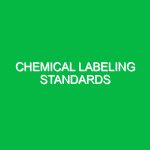Introduction to Safety Data Sheets (SDS)
Understanding Safety Data Sheets (SDS) is crucial for anyone involved in the Health, Safety, and Environment (HSE) domain. Safety Data Sheets are essential documents that provide detailed information about the properties, hazards, and safe handling of chemical substances. These documents serve as a vital communication tool between manufacturers, employers, and employees, ensuring that everyone is informed about the risks associated with chemical products.
In today’s fast-paced industrial environment, the significance of SDS cannot be overstated. Whether you work in a laboratory, a factory, or any setting that involves chemicals, having access to and understanding these documents can mean the difference between maintaining a safe workplace and facing serious health and safety risks. For instance, during my tenure at a manufacturing plant, I witnessed firsthand how a comprehensive understanding of SDS prevented a potential chemical spill that could have led to severe injuries. This experience solidified my belief in the importance of SDS in promoting workplace safety.
The Structure of Safety Data Sheets
Safety Data Sheets typically follow a standardized format, which consists of 16 sections. Understanding the structure of these sections can help users quickly locate vital information. Here’s a brief overview:
1. Identification
This section identifies the chemical and provides contact information for the manufacturer or distributor. It often includes recommended uses and any restrictions.
2. Hazard Identification
Here, the document outlines the hazards associated with the chemical, including classifications and warning symbols. This section is crucial for understanding the potential risks.
3. Composition/Information on Ingredients
This section lists the chemical ingredients and their concentrations. Knowing the components of a substance is essential for assessing risks accurately.
4. First-Aid Measures
In the event of exposure, this section provides guidance on immediate first-aid actions. For example, if a chemical is inhaled, it may recommend moving the person to fresh air.
5. Fire-Fighting Measures
This part describes suitable extinguishing methods and any specific hazards that may arise in a fire situation.
6. Accidental Release Measures
In case of spills or leaks, this section outlines the procedures for containment and cleanup.
7. Handling and Storage
Guidelines on safe handling and storage practices can be found here, emphasizing the importance of proper ventilation and incompatible materials.
8. Exposure Controls/Personal Protection
This section provides recommendations for personal protective equipment (PPE) and exposure limits to minimize health risks.
9. Physical and Chemical Properties
Information on the substance’s physical and chemical characteristics, such as boiling point and solubility, is detailed here.
10. Stability and Reactivity
Understanding whether a substance is stable or reactive is crucial for safe handling. This section provides details on potential hazardous reactions.
11. Toxicological Information
Health effects, including symptoms of exposure and routes of entry, are detailed in this section.
12. Ecological Information
This section covers the potential environmental impacts of the chemical, which is essential for companies seeking to minimize their ecological footprint.
13. Disposal Considerations
Guidance on proper disposal methods is provided here, ensuring compliance with environmental regulations.
14. Transport Information
Details on how to safely transport the substance, including classification for transport, are outlined in this section.
15. Regulatory Information
This part summarizes safety, health, and environmental regulations specific to the chemical.
16. Other Information
Any additional information that may be pertinent to the use of the chemical can be found in this last section.
Hazards and Risks Associated with Chemicals
Understanding Safety Data Sheets (SDS) involves recognizing the potential hazards and risks associated with the chemicals you work with. Each chemical presents unique dangers, from flammability to toxicity. For example, one common hazard is chemical burns, which can occur from exposure to corrosive substances. I recall a situation where an employee suffered a minor chemical burn due to a lack of awareness about the proper PPE required while handling a cleaning agent. The incident underlined the necessity of having accessible and comprehensible SDS.
Another prevalent risk is inhalation of vapors. Chemicals that emit harmful fumes can pose significant respiratory hazards. An anecdote from a colleague who works in a laboratory setting highlights the importance of proper ventilation and the use of respirators when handling volatile organic compounds (VOCs). In their lab, a failure to follow SDS recommendations led to an evacuation due to elevated levels of VOCs, emphasizing the critical role of SDS in preventing such incidents.
Safety Precautions and Best Practices
To mitigate the hazards associated with chemicals, following safety precautions and best practices is essential. Here are some actionable steps:
1. Always Read the SDS
Before working with any chemical, take the time to read and understand the SDS. Familiarize yourself with the specific hazards and recommended safety measures. This foundational step can prevent accidents before they occur.
2. Use Personal Protective Equipment (PPE)
Always wear the appropriate PPE as recommended in the SDS. This might include gloves, goggles, or respirators, depending on the nature of the chemical. In one instance, a colleague neglected to wear gloves while handling a solvent, resulting in skin irritation. Such experiences are powerful reminders of the importance of adhering to safety protocols.
3. Ensure Proper Ventilation
Ensure that workspaces are well-ventilated to minimize inhalation risks. For instance, using fume hoods when working with hazardous vapors can significantly reduce exposure.
4. Implement Emergency Procedures
Be familiar with emergency procedures outlined in the SDS. Knowing how to respond in case of exposure or spills can save lives. In my experience, conducting regular safety drills based on SDS information helped instill a culture of safety among employees.
5. Proper Storage
Store chemicals according to the guidelines provided in the SDS. Incompatible substances should be stored separately to prevent dangerous reactions. A real-world example is the catastrophic explosion caused by improperly stored flammable materials in a warehouse, which could have been avoided with better adherence to storage guidelines.
Regulations and Standards Governing Safety Data Sheets
Understanding Safety Data Sheets (SDS) is not only a best practice; it is also a regulatory requirement in many jurisdictions. The Occupational Safety and Health Administration (OSHA) in the United States mandates that employers provide access to SDS for hazardous chemicals used in the workplace. This regulation underscores the importance of SDS in protecting worker safety.
In addition to OSHA, there are other standards and regulations that govern the use of SDS. The Globally Harmonized System of Classification and Labelling of Chemicals (GHS) provides a framework for standardizing chemical classification and labeling worldwide. This system enhances global communication regarding chemical risks, making it easier for workers to understand potential hazards.
Furthermore, in Europe, the Registration, Evaluation, Authorisation, and Restriction of Chemicals (REACH) regulation requires manufacturers to provide detailed information about the chemicals they produce, including safety data sheets. Adhering to these regulations is essential for compliance and, more importantly, for ensuring the safety of all individuals who may come into contact with hazardous substances.
Conclusion
Understanding Safety Data Sheets (SDS) is an indispensable component of ensuring health and safety in any environment that involves chemicals. By familiarizing yourself with the structure of SDS, recognizing potential hazards, and implementing safety precautions, you can protect yourself and your colleagues from the risks posed by chemical substances. The regulations surrounding SDS further emphasize their importance in fostering a culture of safety. As we continue to navigate an increasingly complex industrial landscape, let’s prioritize safety by making the most of the information available in SDS. Remember, the knowledge you gain from an SDS can be your best ally in preventing accidents and ensuring a safe workplace.


